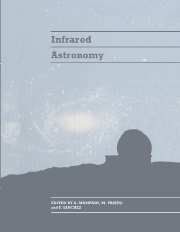Book contents
- Frontmatter
- Contents
- List of Participants
- Preface
- 1 Star Formation
- 2 Last Stages of Stellar Evolution
- 3 The Milky Way Galaxy and the Galactic Centre
- 4 Galaxies in the Infrared
- 5 Cosmology
- 6 G25.2+0.2, a New Ring Nebula Around a Luminous Blue Star: Case Study for the Importance of IR Observations
- 7 Two Colloquia on Cosmic Dust
- 8 Infrared Instrumentation
- 9 Infrared Astronomy with Satellites
8 - Infrared Instrumentation
Published online by Cambridge University Press: 23 December 2009
- Frontmatter
- Contents
- List of Participants
- Preface
- 1 Star Formation
- 2 Last Stages of Stellar Evolution
- 3 The Milky Way Galaxy and the Galactic Centre
- 4 Galaxies in the Infrared
- 5 Cosmology
- 6 G25.2+0.2, a New Ring Nebula Around a Luminous Blue Star: Case Study for the Importance of IR Observations
- 7 Two Colloquia on Cosmic Dust
- 8 Infrared Instrumentation
- 9 Infrared Astronomy with Satellites
Summary
THE INFRARED WAVEBAND
The infrared region of the electromagnetic spectrum spans a large range in wavelengths compared to that of normal visible light and it has not been easy to develop technologies which allow astronomers to study the infrared waveband. However, in the last 8 – 10 years there has been a tremendous growth in the field of infrared astronomy. This growth has been stimulated in part by the construction of infrared telescopes and by successful space missions, but the most important event has been the development of very sensitive imaging devices called infrared arrays. Before describing these detectors and their uses in instrumentation, it is useful to begin with a brief historical review of infrared astronomy and an explanation of the terminology of the subject.
Historical review: from Herschel to IRAS
Infrared astronomy had an early beginning when, in 1800, Sir William Herschel noted that a thermometer placed just beyond the red end of the optical spectrum of the Sun registered an increase in temperature due to the presence of invisible radiation which he called calorific rays. He even demonstrated that these rays were reflected and refracted like ordinary light. This discovery came 65 years before James Clerk Maxwell's theory on the existence of an entire spectrum of electromagnetic radiation.
Despite that early start, and some additional development of infrared detectors by Edison, and later by Golay, no major breakthroughs in infrared astronomy occurred until the 1950s — the era of the transistor — when simple, photoelectric detectors made from semiconductor crystals became possible.
- Type
- Chapter
- Information
- Infrared Astronomy , pp. 335 - 378Publisher: Cambridge University PressPrint publication year: 1994
- 1
- Cited by



